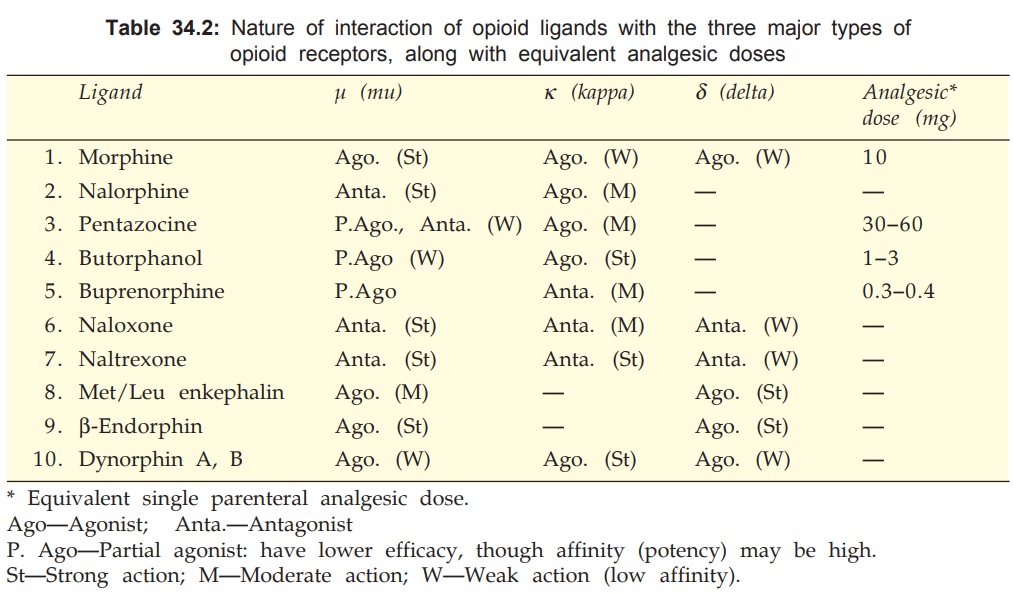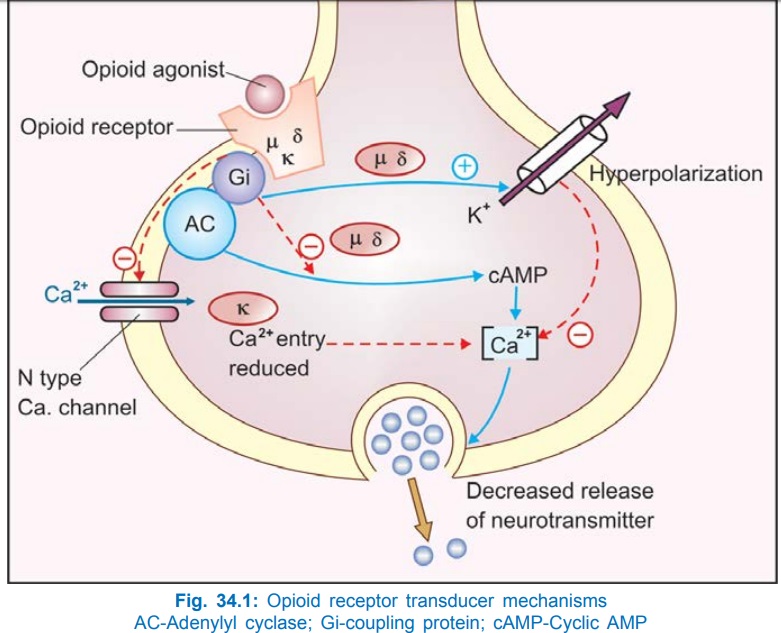Opioid Receptors
| Home | | Pharmacology |Chapter: Essential pharmacology : Opioid Analgesics And Antagonists
Morphine and other opioids exert their actions by interacting with specific receptors present on neurones in the CNS and in peripheral tissues.
OPIOID RECEPTORS
Morphine and other opioids exert their actions by interacting
with specific receptors present on neurones in the CNS and in peripheral
tissues. Chemical modification of morphine structure has yielded a number of
compounds which have a complex pattern of morphinelike and other agonistic and
antagonistic actions that cannot be explained on the basis of a single opioid
receptor. Radioligand binding studies have divided the opioid receptors into three
types (μ, κ, δ); which have been
cloned. Each has a specific pharmacological profile and pattern of anatomical
distribution in the brain, spinal cord and peripheral tissues. Subtypes of μ and κ receptor have been
identified. The proposed functional role of the 3 types of opioid receptors is
listed in Table 34.1.

Opioid ligands can interact with different opioid receptors as
agonists, partial agonists or competitive antagonists. The overall pattern of
effect of a particular agent depends not only on the nature of its interaction
with different opioid receptors, but also on its relative affinity for these,
e.g. morphine is an agonist on μ, κ and δ receptors, but its affinity for μ receptors is much
higher than that for the other two. The effects, therefore, are primarily the
result of μ receptor activation.
The nature and intensity of action of complex action opioids and
antagonists are summarized in Table 34.2.

μ receptor
The μ receptor is characterized by its high affinity for
morphine. It is the major receptor mediating actions of morphine and its
congeners. Endogenous ligands for μ receptor— peptides called Endomorphins 1 and 2—have only recently
been found in mammalian brain—produce biological effects ascribed to this
receptor. Other opioid peptides viz. βendorphin, enkephalins
and dynorphins bind to μ receptor with lower affinity. βfunaltrexamine is a relatively
selective but irreversible μ antagonist. High density of μ receptors has been
detected in periaqueductal gray, thalamus, nucleus tractus solitarious, nucleus
ambiguus and area postrema.
Two subtypes of μ receptor have been
proposed:
μ1: Has higher
affinity for morphine, mediates supraspinal analgesia and is selectively
blocked by naloxonazine.
μ2: Has lower affinity for
morphine, mediates spinal analgesia, respiratory depression and
constipating action.
κ receptor
This receptor is
defined by its high affinity for ketocyclazocine
and dynorphin A; the latter is considered to be its endogenous ligand. Norbinaltorphimine is a selective κ antagonist. Two
subtypes of κ receptor κ1 and κ3 are functionally
important. Analgesia caused by κ agonists is primarily
spinal (through κ1 receptor). However, κ3 receptors mediate
lower ceiling supraspinal analgesia. Other κ actions are listed in
Table 34.1.
δ receptor
This receptor has high
affinity for leu/met
enkephalins which are its endogenous ligands. The δ mediated analgesia is
again mainly spinal (δ receptors are present in dorsal horn of
spinal cord), but the affective component of supraspinal analgesia appears to
involve δ receptors because these
receptors are present in limbic areas—also responsible for dependence and
reinforcing actions. The proconvulsant action is more prominent in δ agonists. Myenteric
plexus neurones express high density of δ receptors—mediate
reduced g.i. motility. Naltrindole is
a selective δ antagonist.
It thus appears that μ and δ receptor responses are quite similar, but
those exerted through κ receptor are distinct. In certain areas κ actions are
antagonistic to μ actions.
The σ (sigma) receptor is
no longer considered an opioid receptor, because it is neither activated by
morphine nor blocked by naloxone. However, certain opioids, e.g. pentazocine,
butorphanol and many unrelated compounds (including some hallucinogens) bind to
σ receptors. Certain
naloxone insensitive effects of pentazocine like drugs, e.g. dysphoria,
psychotomimetic action, tachycardia, mydriasis are believed to be mediated by σ receptors.
Opioid Receptor Transducer Mechanisms
All 3 types of opioid receptors (μ, κ, δ) have been cloned;
all are Gprotein coupled receptors located mostly on prejunctional neurones.
They generally exercise inhibitory modulation by decreasing release of the
junctional transmitter (Fig. 34.1). As such, various monoaminergic (NA, DA, 5HT),
GABA, glutamate (NMDA/ AMPA) pathways are intricately involved in opioid
actions.

Opioid receptor
activation reduces intracellular cAMP formation and opens K+ channels (mainly
through μ and δ receptors) or
suppresses voltage gated N type Ca2+ channels (mainly κ receptor). These
actions result in neuronal hyperpolarization and reduced availability of
intracellular Ca2+ → decreased neurotransmitter release by CNS and myenteric
neurones (e.g. glutamate from primary nociceptive afferents).
However, other mechanisms
and second messengers may also be involved, particularly in the long-term.
Related Topics
